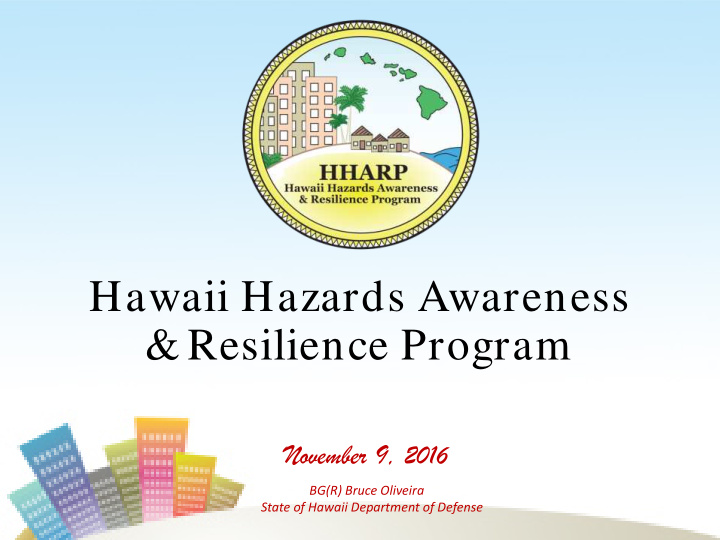



Hawaii Hazards Awareness & Resilience Program November 9, 2016 BG(R) Bruce Oliveira State of Hawaii Department of Defense
Hawaii Hazards Awareness & Resilience Program: GOAL: To enhance community resilience to multiple hazards through a facilitated education and outreach program that promotes hazard understanding and awareness, and offers tools and information resources to guide mitigation, preparedness, response and recovery. 2
Situation – Hawaii Catastrophic Plan • 650,000 people will seek shelter post landfall • 350,000 residences (78% of the residential structures) will be destroyed or significantly damaged • Island will be without a power grid for over a month • Estimated 38M cubic yards of debris • Ports will be severely damaged
Catastrophic Di Disa saster er Oper Operations – Sequence o of Response Critical Resource Gaps Requirements LEVEL OF EFFORT Federal Resources State Resources EVENT TIME Local Need for Federal-State-County- Resources Community Integration (One System)
The Program • Recognizes that “Building Resilient Communities” is an ongoing process . • Establishes measures or milestones of resilience. • Includes guidance for program administration and implementation. This image cannot currently be displayed. 6
Synergies with Other Programs • HHARP resources and tools will assist communities in meeting TsunamiReady/ StormReady guidelines, or renewing their application. • HHARP resources are intended to complement TsunamiReady and StormReady programs, and help communities take steps beyond readiness and towards resilience. 7
Strategy for Success • The program leverages existing agency activities and Hawaii-specific resources. • Expands collaboration and partnership. 8
What is Meant by “Community?” • “Community” is a relative term • Can be defined by geographical or administrative boundaries, culture, ethnicity, shared ideals, or circumstances. • Typically have something in common (place, condition, interest, interdependencies, etc.) • Defining “community” by administrative boundaries is less practicable in Hawaii due to the County being the lowest level of government. 9
HHARP Communities • Completed HHARP Program • Waimanalo • Kailua • Joint Base Pearl Harbor Hickam • Aina Haina • Active Communities • Hawaii Kai • Waianae Coast • Ewa Beach • Kaneohe - Kahaluu • Manoa • Hanapepe • Keaukaha • West Maui • Queued Communities • Kaimuki • Hauula • Kekaha • Hanalei • Milolii 10
What is Meant by Community Resilience? • A community that is capable of caring for itself during and after natural hazard events, and restoring basic structures and functions within a relatively short period of time, is better equipped to deal with the negative human health, environmental, and economic impacts so common after a disaster. 11
Administering the Program State and County Partners: • Publicize and generate interest in the program; • Identify Program Facilitators; • Disseminate HHARP resources; • Assist communities in meeting HHARP milestones; • Review and validate HHARP applications for recognition; • Recognize communities that meet all program milestones; and • Sustain interest and engagement in the program.
Implementing the Program Community Facilitators: • Maintain dialogue between communities and Program Administrators • Act as primary points of contact; • Recipients/custodians of the HHARP Resource Kits; • Organize and facilitate outreach sessions and support community achievement of HHARP milestones; • Maintain documentation; and • Complete and submit HHARP applications for recognition.
HHARP Modules • Module 1: Increases awareness of Hawaii’s most destructive hazards; • Module 2: Enhances understanding of official warning information, and educates residents about response actions; • Module 3: Improves personal preparedness; • Module 4: Helps communities identify skills and resources that may be useful before, during, or after a disaster; • Module 5: Helps communities understand their risks and vulnerabilities; 14
HHARP Modules • Module 6: Helps communities develop an emergency plan; • Module 7: Provides hazard scenarios to exercise community emergency plans; • Module 8: Helps communities select appropriate hazard mitigation measures; • Module 9: Provides display materials to support community outreach events; and • Module 10: Identifies opportunities for additional training and education related to disaster management. 15
HHARP Milestones • Each Module is designed to help communities meet specific objectives. • Activities associated with each Module help communities achieve resilience Milestones. • Communities that accomplish all Milestones are recognized by the State of Hawaii upon completion and validation of a HHARP Application for Recognition . 16
Strategies for Successful Outreach • Provide Credible Information • Keep it Simple • Repeat, Revisit, Reinforce • Information ≠ Understanding • Provide Support when Questions Arise • Get to Know the Community • Utilize Existing Venues • Pursue Multiple Channels of Influence • Include the Business Community • Make the Media your Friend 17
Benefits • Includes latest available resources from credible sources. • Offers a consistent information base for outreach efforts. Accessible. Quick reference. • Intended to empower…enable…boost efficacy…build confidence…formalize the program… • Promotes sharing of information, knowledge, experience, and sound practices. • Builds community resilience to Hawaii’s natural hazards. 18
Hawaii National Guard State Active Duty Missions • Volcanic flows: Pahoa • Hurricanes / tropical storms / floods / tsumanis: Iwa, Iniki, Iselle • Earthquakes: • Hawaii • Fires: • Molokai, • Hawaii, • Oahu 19
Que uestions ns??? ??? 20
MAHALO Point of Contact: Arlene Agbayani, Hawaii Emergency Management Agency Phone: (808) 733-4300 extension 529 21
Recommend
More recommend